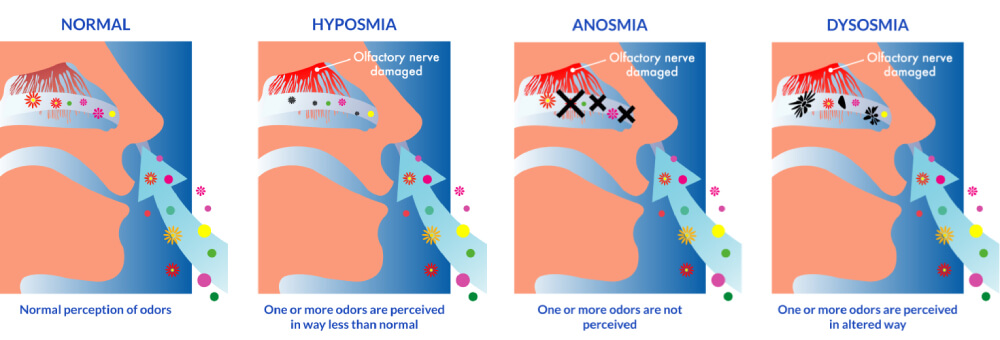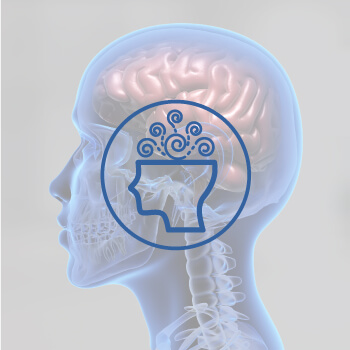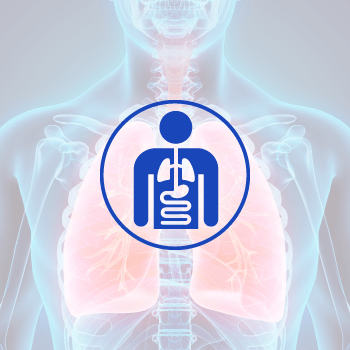Olfactory Dysfunction (smell disturbance)
Olfactory Dysfunction
Olfactory dysfunction is a condition characterized by the loss or impairment of the sense of smell, varying from partial to complete inability to detect odors.
Hyposmia
- Symptoms:
- Reduced ability to detect and identify odors.
- Difficulty in experiencing and distinguishing various scents.
- Impaired sense of taste due to the close connection between smell and taste.
Dysosmia
- Symptoms:
- Perception of odors as unpleasant or different from their actual nature.
- Misidentification of smells.
- Unusual or distorted olfactory sensations.
Anosmia
- Symptoms:
- Inability to detect any odors.
- Loss of the sense of taste, as taste is closely linked to smell.
- Potential safety concerns, as individuals may not detect harmful smells like gas or smoke.

- Causes:
- Complications & Risks:
- Diagnosis:
- Treatment:
Some of the common causes of hyposmia include:
- Nasal Congestion: Conditions leading to nasal congestion, such as allergies or infections, can result in reduced olfactory function.
- Viral Infections: Certain viral infections affecting the nasal passages can contribute to diminished smell.
- Medications: Some medications may have hyposmia as a side effect.
- Aging: Gradual changes in olfactory function can occur with age.
Causes of dysosmia include:
- Sinus Infections: Infections affecting the sinuses can cause distortions in the perception of smells.
- Head Injuries: Traumatic head injuries may lead to altered or distorted olfactory sensations.
- Neurological Disorders: Conditions affecting the nervous system, such as migraines or epilepsy, can contribute to dysosmia.
- Chemical Exposure: Contact with certain chemicals or toxins may result in distorted olfactory perceptions.
Causes of anosmia include:
- Respiratory infections: Common colds, sinus infections, or other respiratory illnesses can temporarily impair the sense of smell.
- Neurological disorders: Conditions such as Alzheimer’s disease, Parkinson’s disease, or multiple sclerosis can impact the olfactory nerves or relevant brain regions.
- Head injuries: Traumatic brain injuries or injuries to the nose and skull can lead to anosmia.
- Nasal and sinus issues: Nasal polyps, sinusitis, or other structural problems in the nasal passages can obstruct the sense of smell.
- Smoking: Tobacco smoke exposure is known to have detrimental effects on the sense of smell.
- Dental problems: Certain dental issues or infections can indirectly affect the olfactory system.
- Hormonal changes: Fluctuations in hormones, such as during pregnancy, can affect the sense of smell.
Common complications and risks include:
- Safety risks: Olfactory dysfunction can impede the detection of hazards like smoke, gas leaks, or spoiled food.
- Quality of life impact: The loss of smell can reduce food enjoyment, impact social interactions, and result in feelings of isolation.
- Psychological impact: Olfactory dysfunction may contribute to emotional distress, including anxiety and depression, especially with prolonged duration.
The loss of smell is a bit difficult to measure. A thorough assessment of the patient’s medical history and a physical examination are crucial for identifying potential causes.
- Odor identification tests: Odor identification tests evaluate your ability to recognize odors and differentiate between them, even as their intensity diminishes through dilution.
- Rhinometry: Diagnostic test used to diagnose and manage nasal conditions, including allergies, nasal congestion, and disorders affecting nasal airflow.
-
Laboratory tests: Thyroid hormone, immunoglobulins, complete blood count and further blood tests.
- Imaging studies: In some cases, imaging studies like MRI or CT scans etc. may be recommended to identify structural abnormalities in the nasal passages or brain.
- CT scans: Utilize X-rays to create detailed brain images
- MRI scans: Use radio waves and magnets for brain visualization
- X-ray of the skull: Provides an image of the skull structure
- Nasal endoscopy: Involves looking inside the nose for examination.
Most often, resolving the primary issue improves your sense of smell and treatment depends on the cause. To treat a decreased (Hyposmia), abnormal (Dysosmia) or absent (Anosmia) sense of smell, interventions may include:
Smell training (perfumes, herbs, spices, oils)
- Platelet rich plasma injection in the/close to the olfactory area (region within the nose for smell).
For nasal irritation:
- Use decongestants, antihistamines, and steroid nasal sprays.
- Take antibiotics prescribed by a doctor for bacterial infections.
- Reduce exposure to nasal irritants and allergens.
- Quit smoking if applicable.
In the case of nasal obstruction:
- Loss of smell caused by nasal obstruction can be treated by removing whatever is obstructing your nasal passage. Consider procedures to remove nasal polyps, straighten the nasal septum, or clear sinuses.
Note that permanent smell loss is more common in older individuals, and there’s currently no treatment for congenital anosmia (present from birth).






 أنقر هنا
أنقر هنا أنقر هنا
أنقر هنا












